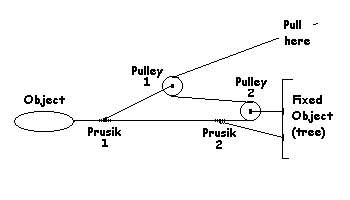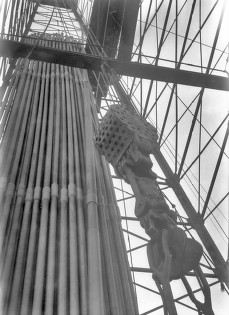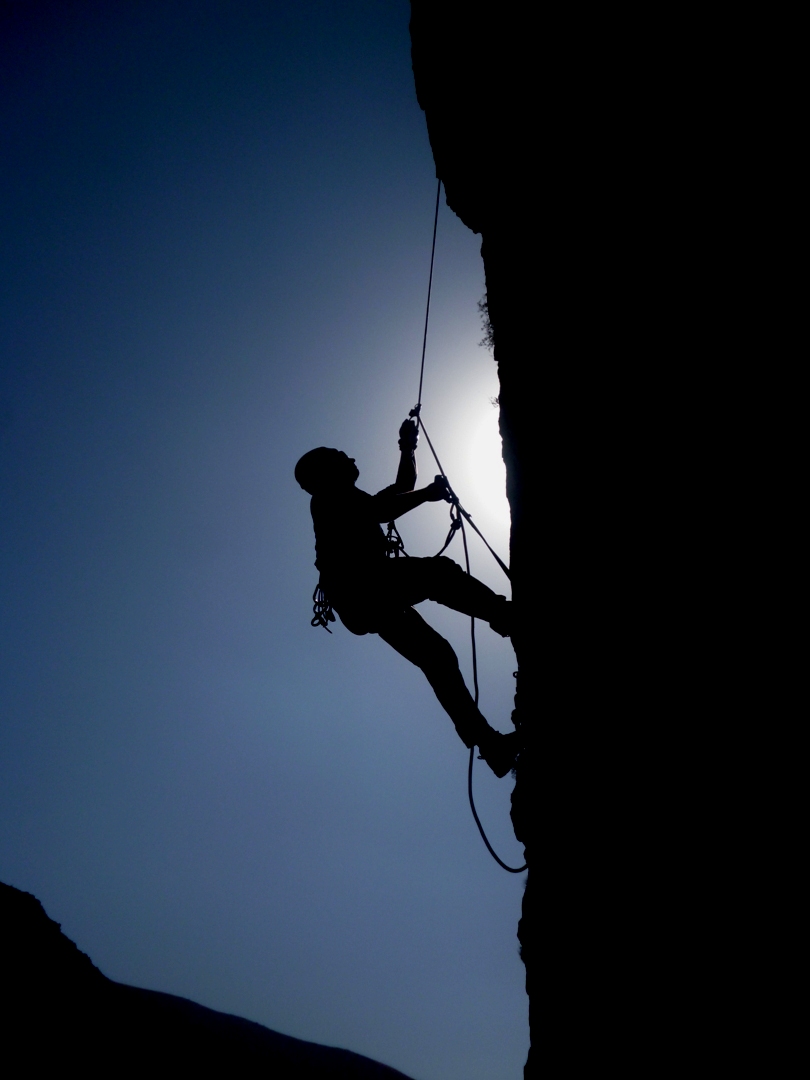|
Z-drag
A Z-Drag or Z-Rig is an arrangement of lines and pulleys, effectively forming a block and tackle, that is commonly used in rescue situations. The basic arrangement results in pulling the hauling end 3 times the distance the load is moved, providing a theoretical mechanical advantage of ''three to one''. In actual practice the advantage will be reduced by friction in the pulleys or carabiners. The advantage will also be reduced if the pull on the hauling end is not parallel to the direction the load moves in. The name comes from the fact that the arrangement of lines is roughly Z shaped. Besides the mechanical advantage to pulling, it also uses only part of the total length of the rope for the block and tackle arrangement. The typical configuration (see diagram) uses two single pulleys and two Prusik knot loops or other suitable friction hitches. These Prusiks provide fixed attachment points on the rope that can be moved when slightly loosened. The first Prusik knot is attached ... [...More Info...] [...Related Items...] OR: [Wikipedia] [Google] [Baidu] |
Block And Tackle
A block and tackle or only tackle is a system of two or more pulleys with a rope or cable threaded between them, usually used to lift heavy loads. The pulleys are assembled to form blocks and then blocks are paired so that one is fixed and one moves with the load. The rope is threaded through the pulleys to provide mechanical advantage that amplifies the force applied to the rope. Hero of Alexandria described cranes formed from assemblies of pulleys in the first century. Illustrated versions of Hero's ''Mechanica'' (a book on raising heavy weights) show early block and tackle systems. Overview A block is a set of pulleys or sheaves mounted on a single frame. An assembly of blocks with a rope threaded through the pulleys is called tackle. The process of threading ropes or cables through blocks is called "reeving", and a threaded block and tackle is said to have been "rove". A block and tackle system amplifies the tension force in the rope to lift heavy loads. They are common ... [...More Info...] [...Related Items...] OR: [Wikipedia] [Google] [Baidu] |
Prusik Knot
A Prusik ( ) is a friction hitch or knot used to attach a loop of cord around a rope, applied in climbing, canyoneering, mountaineering, caving, rope rescue, ziplining, and by arborists. The term Prusik is a name for both the loops of cord used to tie the hitch and the hitch itself, and the verb is "to prusik" (using a Prusik to ascend). More casually, the term is used for any friction hitch or device that can grab a rope (see autoblock). Due to the pronunciation, the word is often misspelled Prussik, Prussick, or Prussic. The Prusik hitch is named after its putative inventor, Austrian mountaineer Karl Prusik. It was shown in a 1931 Austrian mountaineering manual for rope ascending. It was used on several mountaineering routes of the era to ascend the final summit, where a rope could be thrown over the top and anchored so that climbers could attain the summit by prusiking up the other side of the rope. A Prusik made from cord does little or no damage to the rope it is attached t ... [...More Info...] [...Related Items...] OR: [Wikipedia] [Google] [Baidu] |
Friction Hitch
A friction hitch is a kind of knot used to attach one rope to another in a way that is easily adjusted. These knots are commonly used in climbing as part of single-rope technique, doubled-rope technique and as "ratchets" to capture progress on a moving rope, most typically in a mechanical advantage system such as a Z-drag. These hitches are a simple and cheap alternative to mechanical ascenders. List of friction hitches See also *List of hitch knots *List of knots This list of knots includes many alternative names for common knots and lashings. Knot names have evolved over time, and there are many conflicting or confusing naming issues. The overhand knot, for example, is also known as the thumb knot. The ... References Son of a Hitch: A Genealogy of Arborists’ Climbing Hitches External links {{Knots Hitch knots Climbing knots ... [...More Info...] [...Related Items...] OR: [Wikipedia] [Google] [Baidu] |
Z Drag
Z (or z) is the 26th and last letter of the Latin alphabet, used in the modern English alphabet, the alphabets of other western European languages and others worldwide. Its usual names in English are ''zed'' () and ''zee'' (), with an occasional archaic variant ''izzard'' ()."Z", ''Oxford English Dictionary,'' 2nd edition (1989); ''Merriam-Webster's Third New International Dictionary of the English Language, Unabridged'' (1993); "zee", ''op. cit''. Name and pronunciation In most English-speaking countries, including Australia, Canada, India, Ireland, New Zealand and the United Kingdom, the letter's name is ''zed'' , reflecting its derivation from the Greek ''zeta'' (this dates to Latin, which borrowed Y and Z from Greek), but in American English its name is ''zee'' , analogous to the names for B, C, D, etc., and deriving from a late 17th-century English dialectal form. Another English dialectal form is ''izzard'' . This dates from the mid-18th century and probably derives fr ... [...More Info...] [...Related Items...] OR: [Wikipedia] [Google] [Baidu] |
Carabiners
A carabiner or karabiner () is a specialized type of shackle, a metal loop with a spring-loaded gate used to quickly and reversibly connect components, most notably in safety-critical systems. The word is a shortened form of ''Karabinerhaken'' (or also short ''Karabiner''), a German phrase for a "spring hook" used by a carbine rifleman, or carabinier, to attach his carabin to a belt or bandolier. Use Carabiners are widely used in rope-intensive activities such as climbing, fall arrest systems, arboriculture, caving, sailing, hot air ballooning, rope rescue, construction, industrial rope work, window cleaning, whitewater rescue, and acrobatics. They are predominantly made from both steel and aluminium. Those used in sports tend to be of a lighter weight than those used in commercial applications and rope rescue. Often referred to as carabiner-style or as mini-biners, carabiner keyrings and other light-use clips of similar style and design have also become popular. Most are ... [...More Info...] [...Related Items...] OR: [Wikipedia] [Google] [Baidu] |
Pulley
A pulley is a wheel on an axle or shaft that is designed to support movement and change of direction of a taut cable or belt, or transfer of power between the shaft and cable or belt. In the case of a pulley supported by a frame or shell that does not transfer power to a shaft, but is used to guide the cable or exert a force, the supporting shell is called a block, and the pulley may be called a sheave. A pulley may have a groove or grooves between flanges around its circumference to locate the cable or belt. The drive element of a pulley system can be a rope, cable, belt, or chain. The earliest evidence of pulleys dates back to Ancient Egypt in the Twelfth Dynasty (1991-1802 BCE) and Mesopotamia in the early 2nd millennium BCE. In Roman Egypt, Hero of Alexandria (c. 10-70 CE) identified the pulley as one of six simple machines used to lift weights. Pulleys are assembled to form a block and tackle in order to provide mechanical advantage to apply large forces. Pulleys are ... [...More Info...] [...Related Items...] OR: [Wikipedia] [Google] [Baidu] |
Rock Climbing
Rock climbing is a sport in which participants climb up, across, or down natural rock formations. The goal is to reach the summit of a formation or the endpoint of a usually pre-defined route without falling. Rock climbing is a physically and mentally demanding sport, one that often tests a climber's strength, endurance, agility and balance along with mental control. Knowledge of proper climbing techniques and the use of specialized climbing equipment is crucial for the safe completion of routes. Because of the wide range and variety of rock formations around the world, rock climbing has been separated into several different styles and sub-disciplines, such as scrambling, bouldering, sport climbing, and trad (traditional) climbing another activity involving the scaling of hills and similar formations, differentiated by the rock climber's sustained use of hands to support their body weight as well as to provide balance. Rock climbing competitions have the objectives of either ... [...More Info...] [...Related Items...] OR: [Wikipedia] [Google] [Baidu] |
Whitewater
Whitewater forms in a rapid context, in particular, when a river's gradient changes enough to generate so much turbulence that air is trapped within the water. This forms an unstable current that froths, making the water appear opaque and white. The term "whitewater" also has a broader meaning, applying to any river or creek that has a significant number of rapids. The term is also used as an adjective describing boating on such rivers, such as whitewater canoeing or whitewater kayaking. Fast rivers Four factors, separately or in combination, can create rapids: gradient, constriction, obstruction, and flow rate. Gradient, constriction, and obstruction are streambed topography factors and are relatively consistent. Flow rate is dependent upon both seasonal variation in precipitation and snowmelt and upon release rates of upstream dams. Streambed topography Streambed topography is the primary factor in creating rapids, and is generally consistent over time. Increased f ... [...More Info...] [...Related Items...] OR: [Wikipedia] [Google] [Baidu] |
Rope Rescue
Rope rescue is a subset of technical rescue that involves the use of rope, be it steel or cable rope, or more commonly used nylon, polyester, or other type of rope. Kernmantle (kern = core and mantle = sheath) rope as it is called, is available in various types: dynamic (stretches to absorb the shock of a falling lead climber or rescue professional) or static (actually low stretch) which is most commonly used in rescue and industrial rope work. Anchoring includes using specialty anchors, as well as things as simple as a length of chain, cable, rope, or webbing wrapped around a pillar, tree, boulder, or such. They provide the security and a point from which a person or subject (the word ''victim'' has dropped, and changed to ''subject'', due to the negative implications of the term ''victim'') can be belayed. Belaying is the act of protecting the climber, rescue professional, or subject in the event of a fall. Various other devices used, including friction rappel (lowering) devices ... [...More Info...] [...Related Items...] OR: [Wikipedia] [Google] [Baidu] |
Tyrolean Traverse
A Tyrolean traverse is a method of crossing through free space between two high points on a rope without a hanging cart or cart equivalent. This is used in a range of mountaineering activities: rock climbing, technical tree climbing, caving, water crossings and mountain rescue. A zip-line is in essence a Tyrolean traverse which is traveled down quickly with the assistance of gravity. Several sources claim that the name comes from the Tyrolean Alps, where climbers are said to have developed the system in the late nineteenth and early twentieth centuries. Description In rock climbing, a Tyrolean traverse is most often used to return to the main part of a wall after climbing a detached pillar. Lost Arrow Spire, a detached pillar in Yosemite Valley, is often abseiled using a dramatic Tyrolean traverse. There are many ways to anchor the line at the two high points but the significant feature is that there is a line strung between them. Many classic locations for Tyrolean traverses ha ... [...More Info...] [...Related Items...] OR: [Wikipedia] [Google] [Baidu] |
Trucker's Hitch
The trucker's hitch is a compound knot commonly used for securing loads on trucks or trailers. This general arrangement, using loops and turns in the rope itself to form a crude block and tackle, has long been used to tension lines and is known by multiple names. Knot author Geoffrey Budworth claims the knot can be traced back to the days when carters and hawkers used horse-drawn conveyances to move their wares from place to place. Variations The portion of the trucker's hitch which differs in the following variations is the method used to form the loop which the working end slides through to produce the mechanical advantage. The different methods of forming the loop affect the ease and speed of tying and releasing and the stability of the final product. The variations are presented in order of increasing stability. Sheepshank style loop This version of the knot uses a sheepshank-like construction, in this kind of application also known as a ''bell ringer's knot'', to for ... [...More Info...] [...Related Items...] OR: [Wikipedia] [Google] [Baidu] |
Mechanical Advantage
Mechanical advantage is a measure of the force amplification achieved by using a tool, mechanical device or machine system. The device trades off input forces against movement to obtain a desired amplification in the output force. The model for this is the ''law of the lever.'' Machine components designed to manage forces and movement in this way are called mechanisms. An ideal mechanism transmits power without adding to or subtracting from it. This means the ideal machine does not include a power source, is frictionless, and is constructed from rigid bodies that do not deflect or wear. The performance of a real system relative to this ideal is expressed in terms of efficiency factors that take into account departures from the ideal. Lever The lever is a movable bar that pivots on a fulcrum attached to or positioned on or across a fixed point. The lever operates by applying forces at different distances from the fulcrum, or pivot. The location of the fulcrum determines ... [...More Info...] [...Related Items...] OR: [Wikipedia] [Google] [Baidu] |






.jpg)


